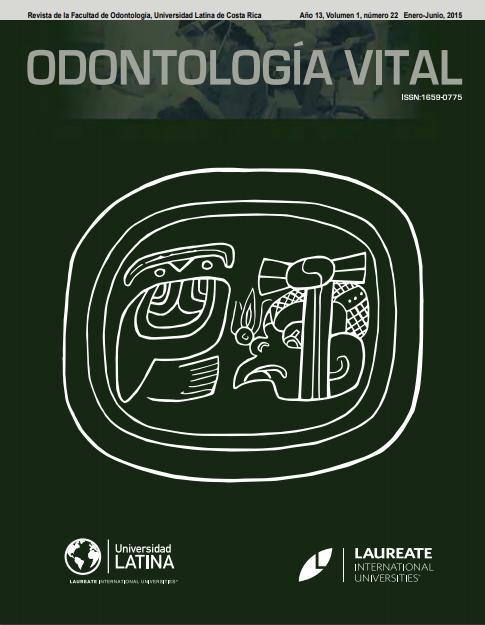Use of bioceramics in pulpotomy as an alternative treatment in patients diagnosed with autism: Clinical case report
DOI:
https://doi.org/10.59334/ROV.v1i22.278Keywords:
Biodentine®, Autism, pulpotomy, pulp vitality, tertiary dentinAbstract
Biodentine ® is a new bioceramic material with excellent mechanical and bioactivity properties, which can be used as substitute for both the coronal and root dentin. It has a positive effect on the pulp’s vitality stimulating cells of the pulp to form tertiary dentin; it can be used directly over the teeth with pulp exposures. This article is a description of a pulpotomy on a female patient of 11 years old, diagnosed with autism. The pulp chamber is filled with Biodentine ®, and checked each month for a period of three months, with final control at 12 months. The cement filler was prepared as a base to replace the dentin and resin composite was placed to replace the enamel layer.
Downloads
References
About I, Raskin A, De Meo M, Déjou J . (2005) Cytotoxicity and Genotoxicity of a new material for direct posterior fillings. Euro Cell Mater; 10: 23
Blenner, S., Reddy, A., & Augustyn, M. (2011). Diagnosis and management of autism in childhood. BMJ, 343(oct21 1), d6238. https://doi.org/10.1136/bmj.d6238
Ferracane, J. L., Cooper, P. R., & Smith, A. J. (2010). Can interaction of materials with the dentin-pulp complex contribute to dentin regeneration? Odontology, 98(1), 2–14. https://doi.org/10.1007/s10266-009-0116-5
Ford, T. R. P., Torabinejad, M., Abedi, H. R., Bakland, L. K., & Kariyawasam, S. P. (1996). Using mineral trioxide aggregate as a Pulp-Capping material. The Journal of the American Dental Association, 127(10), 1491–1494. https://doi.org/10.14219/jada.archive.1996.0058
Goldberg, M., & Pradelle-Plasse, N. (2009). Biocompatibility or cytotoxic effects of dental composites (1st ed.). Coxmoor Publishing Company.
Johnson, C. P., & Myers, S. M. (2007). Identification and evaluation of children with autism spectrum disorders. PEDIATRICS, 120(5), 1183–1215. https://doi.org/10.1542/peds.2007-2361
Koubi, G., Colon, P., Franquin, J., Hartmann, A., Richard, G., Faure, M., & Lambert, G. (2012). Clinical evaluation of the performance and safety of a new dentine substitute, Biodentine, in the restoration of posterior teeth — a prospective study. Clinical Oral Investigations, 17(1), 243–249. https://doi.org/10.1007/s00784-012-0701-9
Koubi, S., Elmerini, H., Koubi, G., Tassery, H., & Camps, J. (2011). Quantitative evaluation by glucose diffusion of microleakage in aged calcium Silicate-Based Open-Sandwich restorations. International Journal of Dentistry, 2012, 1–6. https://doi.org/10.1155/2012/105863
Marsellasch Gloria. (2010). NINDS Instituto Nacional de Trastornos Neurológicos y Accidentes Cerebrovasculares http://espanol.ninds.nih.gov/trastornos/autismo.htm
Pelegrí H.M., (2011) BIODENTINE® - Eficaz tecnología en biosilicatos. Canal Abierto. 24: 16-19. Disponible en: http://www.socendochile.cl
Pradelle-Plasse N, Tran Xuan-Vin C. (2009) Physico-chemical properties of Biodentine. In: Goldberg M, ed. Bio-compatibility or Cytotoxic Effects of Dental Composites, 1st ed. Oxford: Coxmoor Publishing Co. p.p. 222.
Quijada Carmen G., (2008). Espectro autista. Rev. chil. pediatr. v.79 supl.1 Santiago nov. 2008 Medline Plus. https://doi.org/10.4067/S0370-41062008000700013
Strassler, H., & Levin, R. (n.d.). Biodentine Tricalcium-Silicate cement. Inside Dentistry. https://www.aegisdentalnetwork.com/id/2011/11/biodentine-tricalcium-silicate-cement
Trastornos del espectro autista | NINDS Español. (n.d.). https://espanol.ninds.nih.gov/es/trastornos/trastornos-del-espectro-autista
Zanini, M., Sautier, J. M., Berdal, A., & Simon, S. (2012). Biodentine Induces Immortalized Murine Pulp Cell Differentiation into Odontoblast-like Cells and Stimulates Biomineralization. Journal of Endodontics, 38(9), 1220–1226. https://doi.org/10.1016/j.joen.2012.04.018
Downloads
Published
Issue
Section
License
Copyright (c) 2015 Mayid Barzuna, Gina Sancho

This work is licensed under a Creative Commons Attribution 4.0 International License.
Authors who publish with Odontología Vital agree to the following terms:
- Authors retain the copyright and grant Universidad Latina de Costa Rica the right of first publication, with the work simultaneously licensed under a Creative Commons Attribution 4.0 International license (CC BY 4.0) that allows others to share the work with an acknowledgement of the work's authorship and initial publication in this journal.
- Authors are able to enter into separate, additional contractual arrangements for the non-exclusive distribution of the Odontología Vital's published version of the work (e.g., post it to an institutional repository or publish it in a book), with an acknowledgement of its initial publication.
- Authors are permitted and encouraged to post their work online (e.g., in institutional repositories or on their website) prior to and during the submission process, as it can lead to productive exchanges, as well as earlier and greater citation of published work.







